Everglades trail surveyed for cultural artifacts
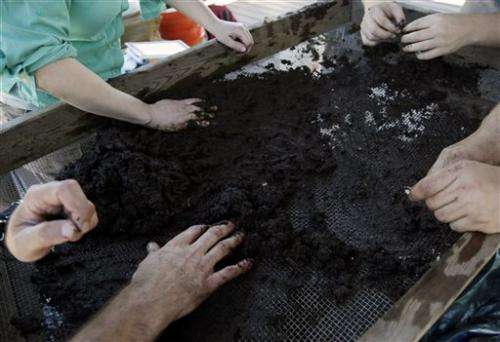
Archaeologists are poking through the muck under a boardwalk in Everglades National Park, looking for evidence of a prehistoric culture.
National Park Service archaeologists are sampling sediment, sucking up mud and water about 10-feet (3-meters) deep with an aluminum tube and then dumping the contents over a screen. When the pond was dredged in 1968 after a record drought, a park ranger noticed hundreds of artifacts, including bone pieces sharpened into tools or weapons, atop a debris pile. The items were collected and the ranger's notes were catalogued, but the site never was excavated.
Archaeologists have returned because the park service wants to replace part of the wooden boardwalk along the Anhinga Trail. The boardwalk allows tourists to experience the landscape without wading through water or stumbling upon alligators.
More than four decades ago, the ranger also found stingray tails, shark teeth and scales from other marine life that would not be found in a freshwater pond, said Margo Schwadron, the park service archaeologist leading the survey.
"It's unique in the sense that it's a submerged site. We don't have very many of those in Florida and in this area at all. That is why it's special," said Penny Del Bene, the park's chief of cultural resources.
Schwadron hopes the dredging 46 years ago didn't destroy a prehistoric cultural site. Based on what the ranger found in 1968, the artifacts hidden potentially thousands of years could be significant to understanding how people lived in the Everglades, she said.
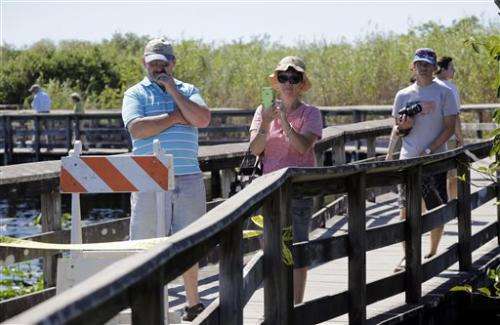
"There's no written record. The only thing we can find is archaeological data and get that and preserve that," Schwadron said.
The work began Friday. As of Monday, archaeologists sifting through the sediment samples with their hands have found burnt pieces of wood, bone fragments and shells, but little else. The items were put into plastic bags filled with yellow-brown water to keep them from drying out before they can be examined in a lab for evidence of human alteration, like cuts or drilled holes.
The painstaking work is made more difficult by the watery work site, which has no clear boundaries in an area well-trafficked by tourists and wildlife.
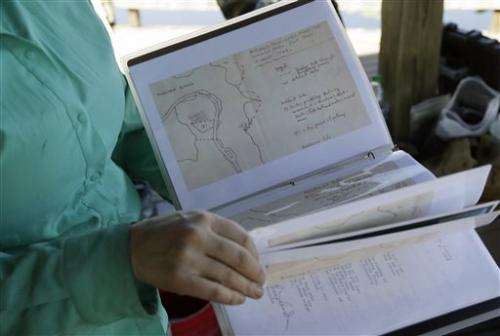
"We have no idea what we're hitting until we bring it up," Schwadron said.
The site is near a slough that has been a target for Everglades restoration efforts. State and federal officials consult with Florida's tribes on how to preserve artifacts or cultural sites affected by restoration projects in the park and on state lands. The location of those sites is often kept secret to prevent looting; anyone who finds an artifact is urged to report its location and leave it undisturbed.
Tourists are warned that anything dropped into the Everglades is more than likely gone for good, but the flowing waters and annual dry seasons sometimes reveal lost treasures. A hunter participating in the state-sanctioned python hunt last year found a half-melted gold pendant that may have belonged to someone aboard a commercial airliner that crashed in the swamps decades ago.
-
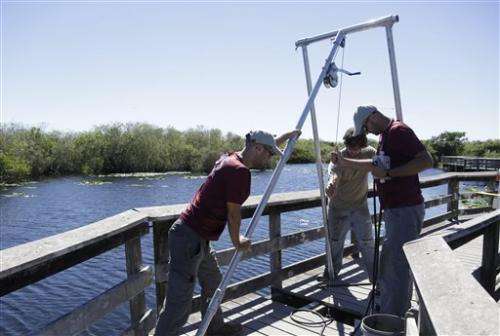
In this Friday, Oct. 17, 2014 photo, National Park Service archaeologists Rusty Simmons, left, Michael Seibert, center, and Eric Bezemek submerge a vibracore device to sample sediment in the Anhinga Slough in Everglades National Park, Fla. They are looking for artifacts which were first discovered at the site when it was dredged in 1968. (AP Photo/Lynne Sladky) -
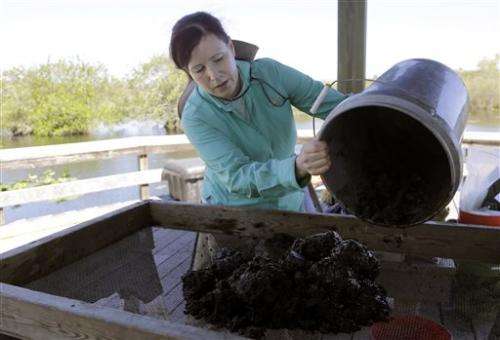
In this Friday, Oct. 17, 2014 photo, National Park Service archaeologist Margo Schwadron dumps sediment collected from the Anhinga Slough onto a sifting tray while doing a survey in Everglades National Park, Fla. Archeologists are looking for artifacts which were first discovered at the site when it was dredged in 1968. (AP Photo/Lynne Sladky)
© 2014 The Associated Press. All rights reserved.


















